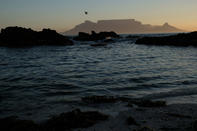Refuelling and Supply Station
When the maritime power of Portugal waned, the rich sea route to the East was hotly contested by English, French and Dutch fleets. But it was the Dutch who prevailed; by the mid-1600s they had a regular stream of ships on the sea and they used Table Bay as a halfway refuelling stop.

When the Nieuw Haerlem was blown onto the shore close to where Milnerton Lighthouse now stands, some of her crew were rescued by two Dutch ships anchored in the bay, while others were taken back to Europe on an English East Indiaman. But it is the 60 who remained to salvage the ship's cargo that are the most interesting.
Nearly a year later, the 60 healthy and happy Dutchmen arrived back in Amsterdam, so full of praise for the place of their confinement that plans were immediately made to set up a permanent supply station on the shores of Table Bay. This the Dutch achieved another four years later.
Milnerton Lighthouse
Milnerton was named after Sir Alfred Milner, Governor of the Cape Colony between 1897 and 1901. The historic wooden bridge to Woodbridge Island was built by British troops in 1901 to defend the coast against possible attacks by Boer guerrilla forces during the South African War.
The 21 m high Milnerton Lighthouse, built in 1960, is a local landmark and is one of only a few cylindrical lighthouses along the South African coast.